
Here's Why You Need to Incorporate Instagram Stories Into Your Campaign
Subscribe to our industry newsletter for the latest influencer marketing trends, collaboration ideas, and up-and-coming bloggers. 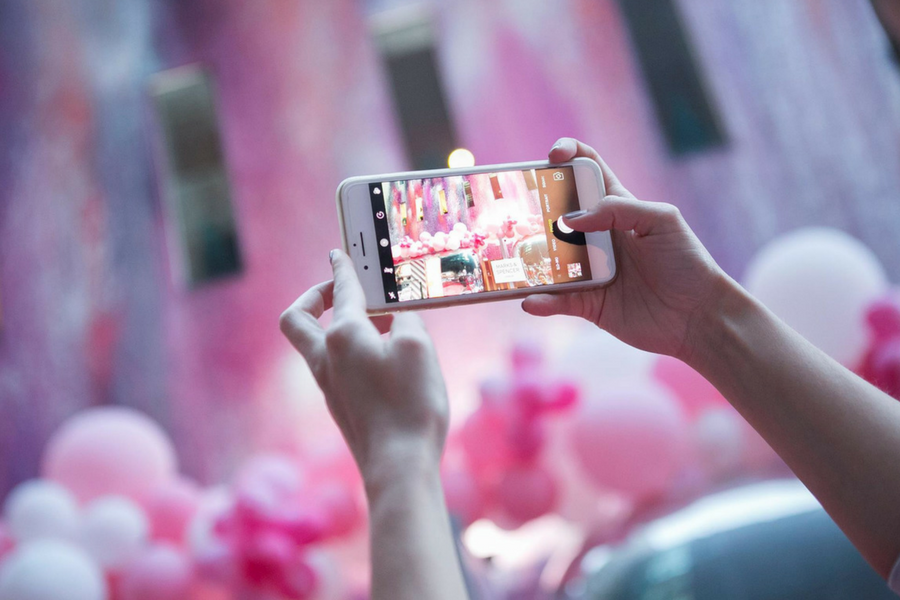
For anyone observing the social media landscape over the last year, the rise of Instagram Stories would be hard to miss. Instagram launched the short-form video feature in 2016 to rival Snapchat, and in less than a year had overtaken its predecessor before going on to surpass Pinterest, Twitter, Reddit and LinkedIn in terms of daily active viewers. More than 300 million people actively use Stories everyday -- nearly half of Instagram’s 800 million monthly active users.
The popularity of Instagram has been good for business: 80% of users voluntarily interact with brands on the platform, and 72% have been influenced to make a purchase through brand interactions on Instagram. Stories have proven to be even more engaging: One in five Instagram Stories receives a direct message from users. In fact, 33% of consumers become more interested in a brand after seeing it on Instagram Stories, according to a survey by Instagram’s parent company Facebook. To illustrate the sheer volume of traffic Stories is now driving, Shopping Links has created this handy, shareable infographic below:
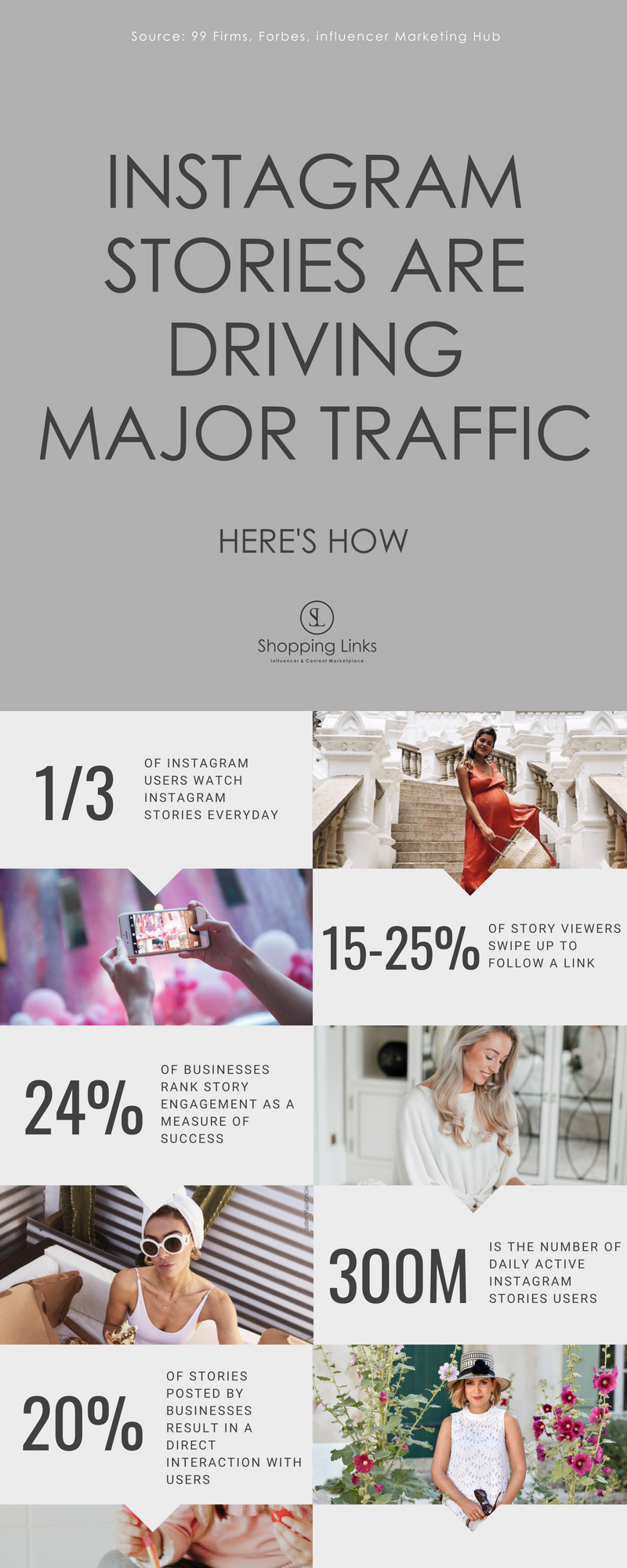
Yet the key value Instagram Stories offers goes beyond its potential for organic engagement. Stories allow brands to drive traffic to their own websites, which makes it an invaluable new source for both traffic generation and tracking.
From our own collaboration results, we can see that the traffic driven by Instagram Stories is rivaling that of traditional channels in their heyday, including top-tier fashion websites, magazines and even television. We have seen bloggers reach nearly 1 million unique viewers in 7 days on Instagram Stories, while amassing a staggering 25 million impressions in the same 7-day period. Brands have historically only achieved this kind of reach after the production costs of full-page ads and 30-second commercials spots, and without the metrics offered through Instagram Stories. When a recent collaboration for a luxury jewelry brand drove more than 400 clicks, we could track that traffic to the brand’s website. It’s this ability to convert, combined with massive reach, that has made Instagram Stories such a powerful tool.
Swipe-up to Drive Traffic
The swipe-up feature of an Instagram Story is available to verified accounts and those with more than 10k followers. The feature has become a powerful tool for driving potential customers to brand-owned content and eCommerce pages, with brands reporting that the lifetime value of an email signup from Instagram Stories is worth more than one from Facebook. The volume of brand traffic Stories has driven is difficult to quantify, but an update that will soon allow consumers to shop select brands directly through the Instagram Stories platform suggests that outbound traffic has been significant, given Instagram’s attempts to start reigning it in.
Recognizing the power of Instagram Stories to convert viewers into shoppers, we have now made them a requirement of our Product Seeding collaboration type, which allows brands to gift influencers at scale. Brands select either 10 or 50 influencers with at least 10k followers on Instagram for a flat rate starting at $895 USD, which includes a guaranteed Instagram post and an Instagram Story from each blogger. Bloggers are required to post within 30 days of receiving product.
Want to learn how to make Instagram Stories work for your brand? Schedule an intro. We’re always happy to help.
Traffic or Sales? Why Traffic Matters
Using Instagram Stories to drive traffic to brand-owned channels has become particularly important in light of recent algorithm updates at Instagram and Facebook. Both sets of updates underscore the risks involved when relying solely on a third-party platform for marketing activities. Released in March, the updates prioritise interactions with other accounts in a user’s personal network while making it more difficult for business accounts to reach viewers organically. Meanwhile, YouTube ran surprise algorithm tests of its own, fueling speculation that it too may be headed for a Facebook-like update.
Algorithms – which rarely benefit brands – have led many marketers to look more earnestly at how they can strengthen their follower relationships outside social media. Although social channels have certainly made it easier for brands to connect with their target audiences, follower counts have become increasingly less indicative of overall reach, and content strategies have become more and more reliant on promoting and advertising.
To safeguard against sudden drops in organic reach, brands continue to focus on collecting email addresses for their EDM campaigns, which allows them to customize their outreach and enact greater control over how they can reach potential customers. Brands are also making greater efforts to develop a stronger relationship with customers. Here’s how marketers are using Instagram Stories to accomplish these goals, and how you can leverage these opportunities for your own brand.
Tactic #1. Become a Cohesive Storyteller
Although Instagram Stories content can certainly stand alone, successful brands are thinking in terms of cohesive, multi-channel storylines. Telling a single story across multiple platforms gives you the advantage of continuity, allowing you to make your Instagram Stories content a single “chapter” with the satisfying conclusion on a channel you own, such as your website. Incorporating influencers can make this strategy particularly effective for two reasons: firstly, you have the potential of a much wider audience; and secondly, influencers are natural storytellers! Bloggers are often more adept than even the best marketing teams at creating storylines viewers want to follow.
Maria Vizuete, the blogger behind Mia Mia Mine, has mastered the art of focusing on a single, eye-catching scene with the promise of a larger story outside Instagram:
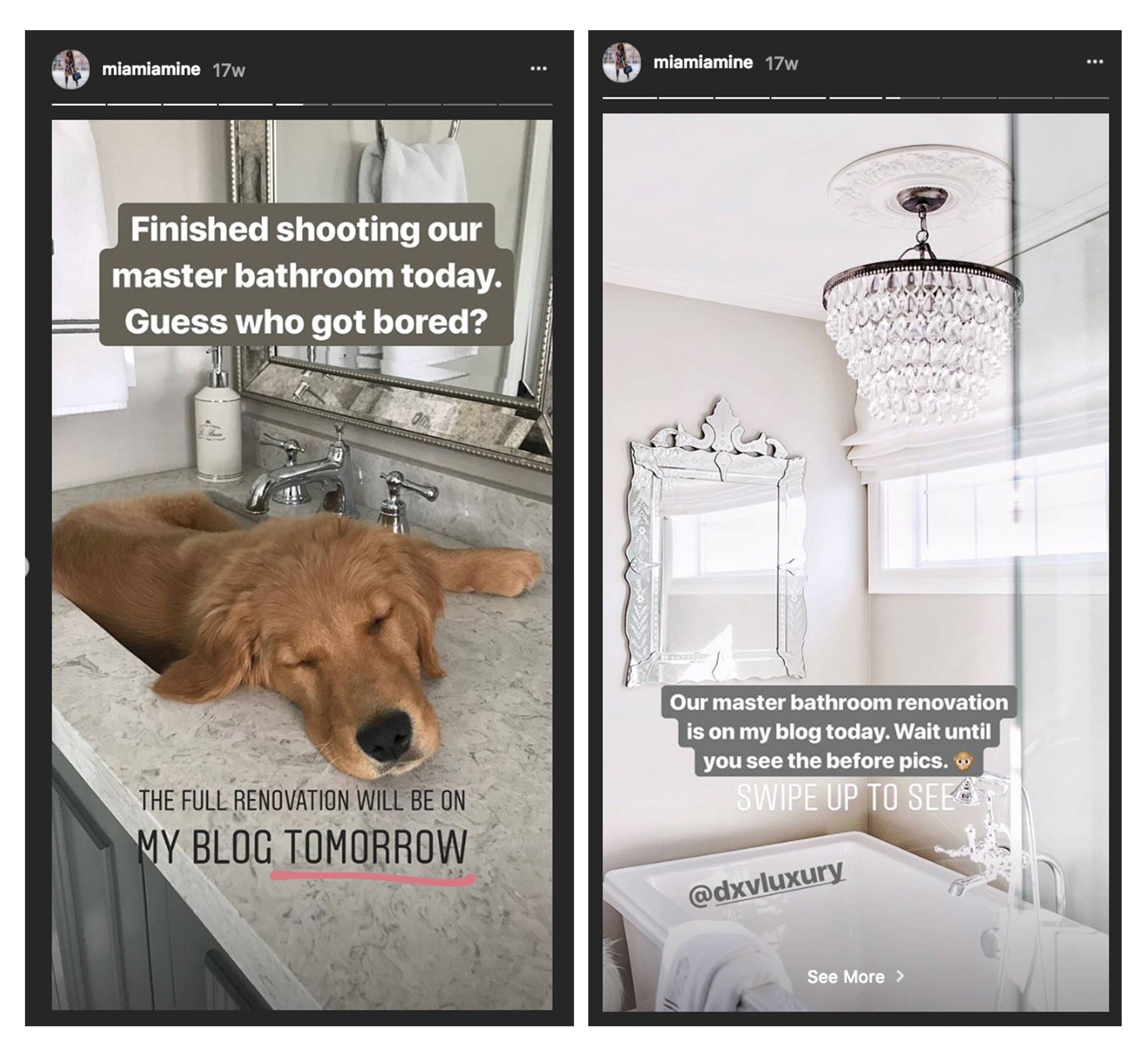
Her approach is both personal and engaging, with a strong “hook” for viewers. (Aren’t you dying to see her finished bathroom?)
Posts of this nature work best when your story has an impactful conclusion that you can reveal on a channel you own, even if an influencer is telling your story. For your own brand, an influencer might show off several styles or colors of a product through Instagram Stories before directing viewers to your shopping page to see the one he or she chose. For even better results, incorporate their content onto your eCommerce website. We recently worked with a leading international retailer who tested influencer content against branded content in a recent EDM and found that influencer content led to a 21.6% uplift in email revenue and a 33% improvement in the click-to-order rate.
Want better results from your email campaigns? Get in touch to see how influencers can help improve your email revenues.
Try it today:
To implement this strategy in your own campaign, think of your Instagram Stories as the prologue or “TV preview” to more in-depth content on your site. Your goal is to quickly capture attention, set up a “hook,” then direct traffic to your own channel. Hinting at more style tips or the “next chapter” of the story can help you capture email addresses, and building on the storylines you’ve started in Stories and on your site can help you keep subscribers engaged.
Tactic #2. Collaborate with Real Shoppers
The popularity of unscripted, ephemeral platforms like Instagram Stories and Snapchat are proving that social media users don’t just want hyper-saturated, aspirational imagery; they also want unfiltered, “behind the scenes” content that reveals the human side of their favorite brands and influencers. Collaborating with influencers can make this strategy particularly effective. MARKS & SPENCER is a brand that consistently does this well, most recently collaborating with Christina Beauchamp (@fashionandfrill) to give shoppers recommendations from their maternity collection straight from a mum-to-be. No matter how informative a marketing campaign might be, an ad will never feel as authentic as a review from an influencer who can relate directly to the target shopper.
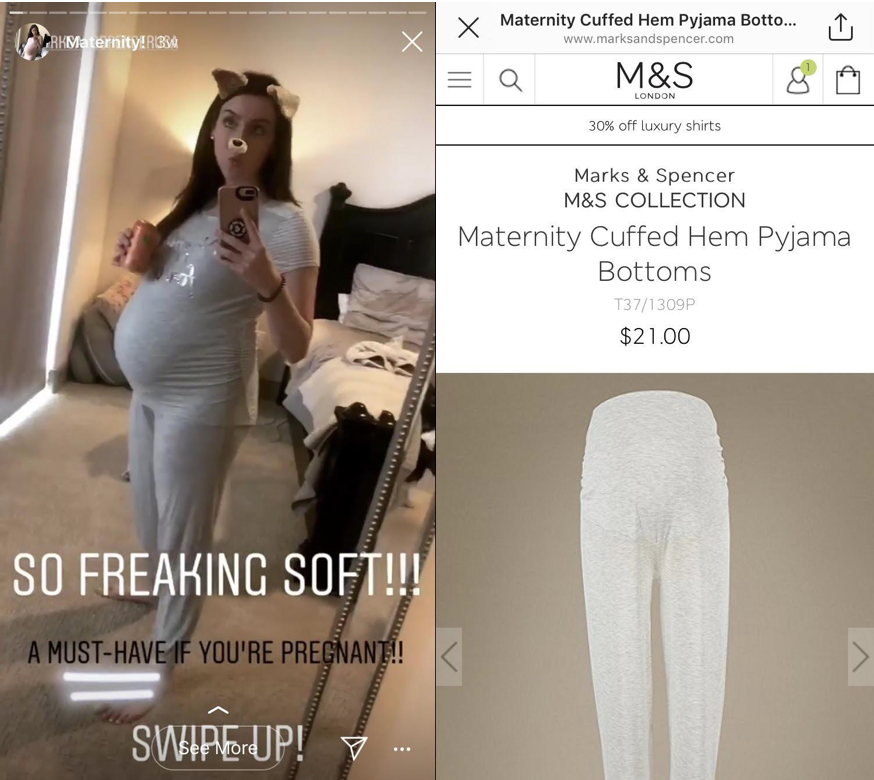
A swipe-up on Christina’s story took viewers to the product page on M&S’ eCommerce site, where they could instantly shop her look. Christina provided details for both her top and bottoms through extra frames, giving M&S even more exposure:
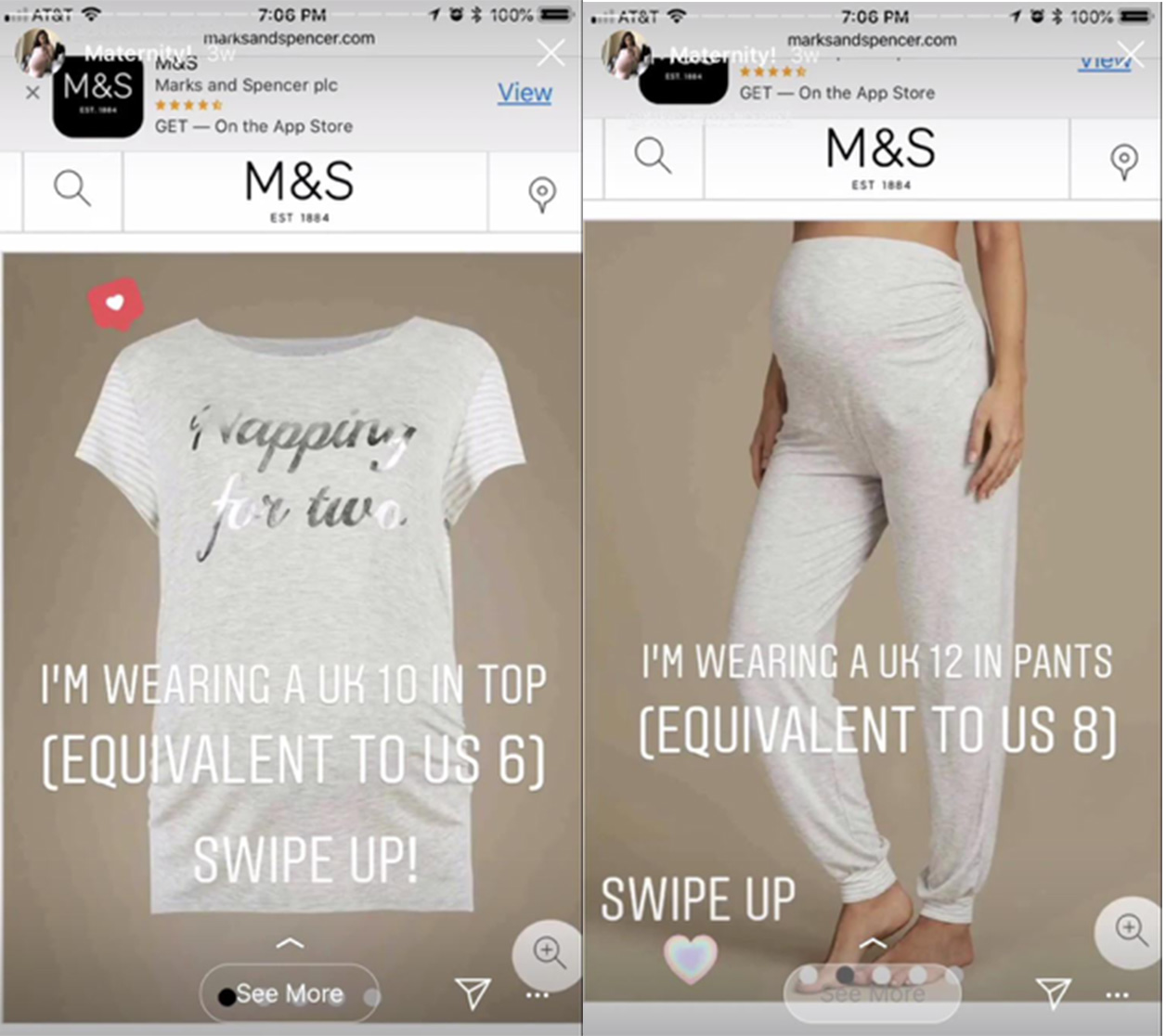
She also posted her M&S outfit on her Instagram feed, ensuring even more exposure for the story, resulting in more than 2,300 likes and 154 comments:
In another great example by M&S, Australian blogger Kyree Harvey (@misskyreeloves) put a spotlight on the brand’s new season styles after sharing her search to find an adult version of her daughter’s pink denim jacket.
Kyree’s series of Stories about the jacket drove traffic to nearly 100k shoppers. Like Christina, Kyree complemented her Stories with Instagram posts, garnering more than 7,000 total likes and over 600 comments:
Try it today:
To incorporate real shoppers into your Instagram Stories campaigns, look to niche influencers who align well with both your brand and the specific products you’re looking to feature. Don’t be afraid to give influencers creative freedom when promoting your product, even if it means appearing alongside other brands. Influencer marketing and user-generated content works because customers trust the content. Finally, when writing your influencer collaboration brief, be sure to include multiple channels – for example, an Instagram post in addition to a story. Reinforcing your message across multiple touchpoints is a highly effective way to ensure more views for your products and more traffic to your eCommerce website or social channels.
Read More: How to Make User Generated Content Work for Your Brand
Want to start incorporating influencers into your Instagram Stories? Get in touch!
We’ll show you how to find the best influencers for your brand, and how to run an impactful collaboration, step by step.
Tactic #3. Make Your Stories Interactive
Understanding your customers is an ongoing process; no shopper’s style, interests or tastes remains stagnant, and neither do your own products! Social media has made it possible to interact directly with your target audience, but simply asking “What do you think?” in a status update doesn’t always yield the best results. Instagram Stories allows you to gain quick, meaningful insights without putting your followers on the spot, while actually making it fun for them to provide feedback.
Australian brand AcquisHair has become a pro at encouraging insights through Instagram Stories polls, utilizing a simple “this/that” question style to better understand what frustrates, delights and annoys its customers.
The questions below might look innocuous, but to an insightful marketer, they’re actually a way to gain insights into what Aquis customers value. If more viewers respond with “sleek” versus “shiny” in the first poll, the brand knows that this word is more likely to resonate with its customers, and in turn can use it more often in its marketing and social media copy.
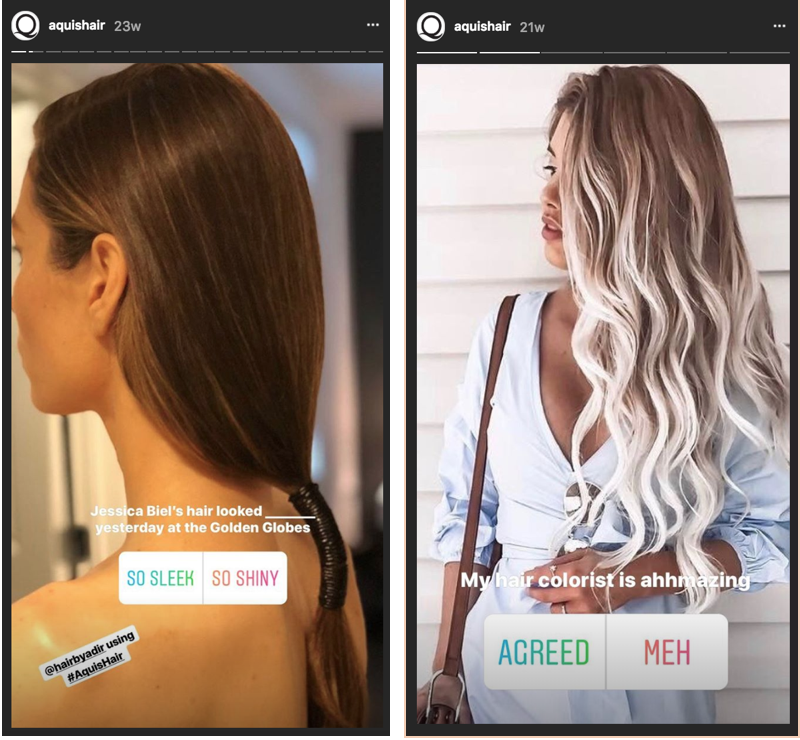
In the second post, viewers give valuable information about how much they value their colorists, which can help AquisHair determine if stylists and colorists are good avenues for introducing its products. If followers report strong positive feelings about their colorists, the brand knows that salons are worth approaching.
Collaborating with influencers is another way to utilize Instagram Story polls, particularly if you’re seeking a high volume of responses. Influencers often engage their followers by asking which products, colors or styles they like, which can make their polls feel less promotional than your own. Influencers can also help you attract more forthright responses. Geneva Vanderzeil (@apairandaspare), for example, often polls her readers about products, craft ideas and content, as she does here.
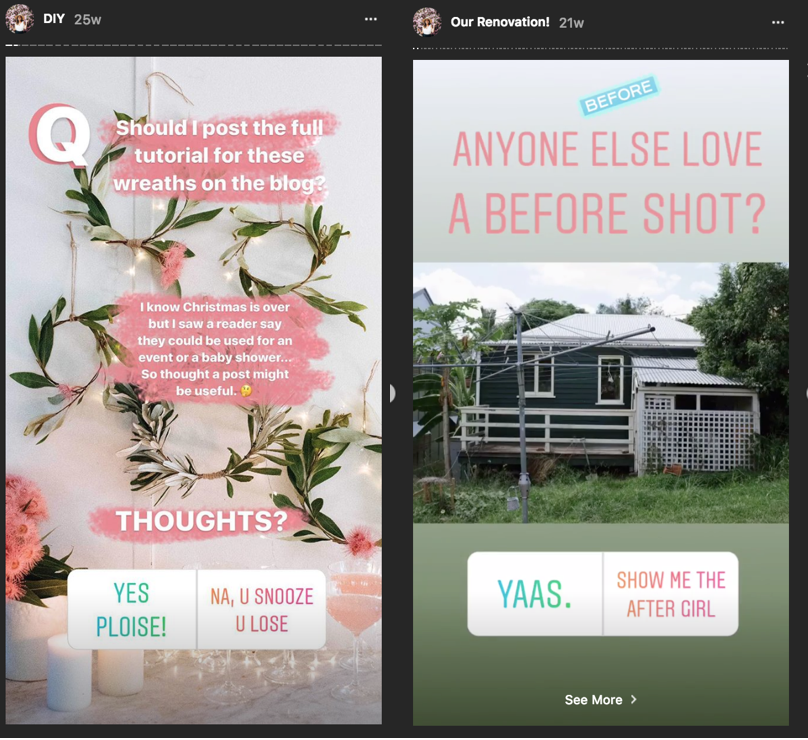
Another way to engage viewers is with contests. You can run these on your own channel or by collaborating with influencers, who can help you quickly reach multiple markets and expand your reach. The type of contest you run depends on your KPIs. If your goal is to expand your loyalty program, you might offer a giveaway to the first 100 viewers who sign up. If you’d like to expand your own Instagram reach, a “like” to enter contest will be more appropriate. In either case, influencers can direct traffic to the right page with a message that inspires action.
Try it today:
When using polls, prioritize the audience experience. You’ll get the insights you need only if you create an entertaining, visually appealing and engaging experience – which is why influencer collaborations are so effective. If you want to maintain control over your poll results and insights, you might also consider hosting an influencer takeover on your account, which allows you to track your insights in real time, while retaining the value of having a trusted name asking the questions. To reach a specific goal – such as increasing sales of a new product or expanding your loyalty program – consider a contest. Combining your contest with an affiliate program that rewards influencers for their referrals can make your campaign even stronger.
The Bottom Line
As Instagram Stories becomes an increasingly powerful tool to expand reach, drive traffic, and increase sales, understanding how to incorporate them into your campaigns can set your brand apart and boost your bottom line. The key to successful Instagram Story campaigns is authenticity and engagement, which makes influencer collaborations a natural fit. Influencers can help you leverage user-generated content by featuring real shoppers, gain genuine customer feedback through polls, and expand your reach by incorporating your brand into compelling storylines.
We have helped brands of all sizes, from emerging brands to leading international retailers, build their audiences and drive revenues with Instagram Stories. Request an intro or get in touch at hello@shoppinglinks.com to see how our network of 15,000+ influencers can help your brand.
